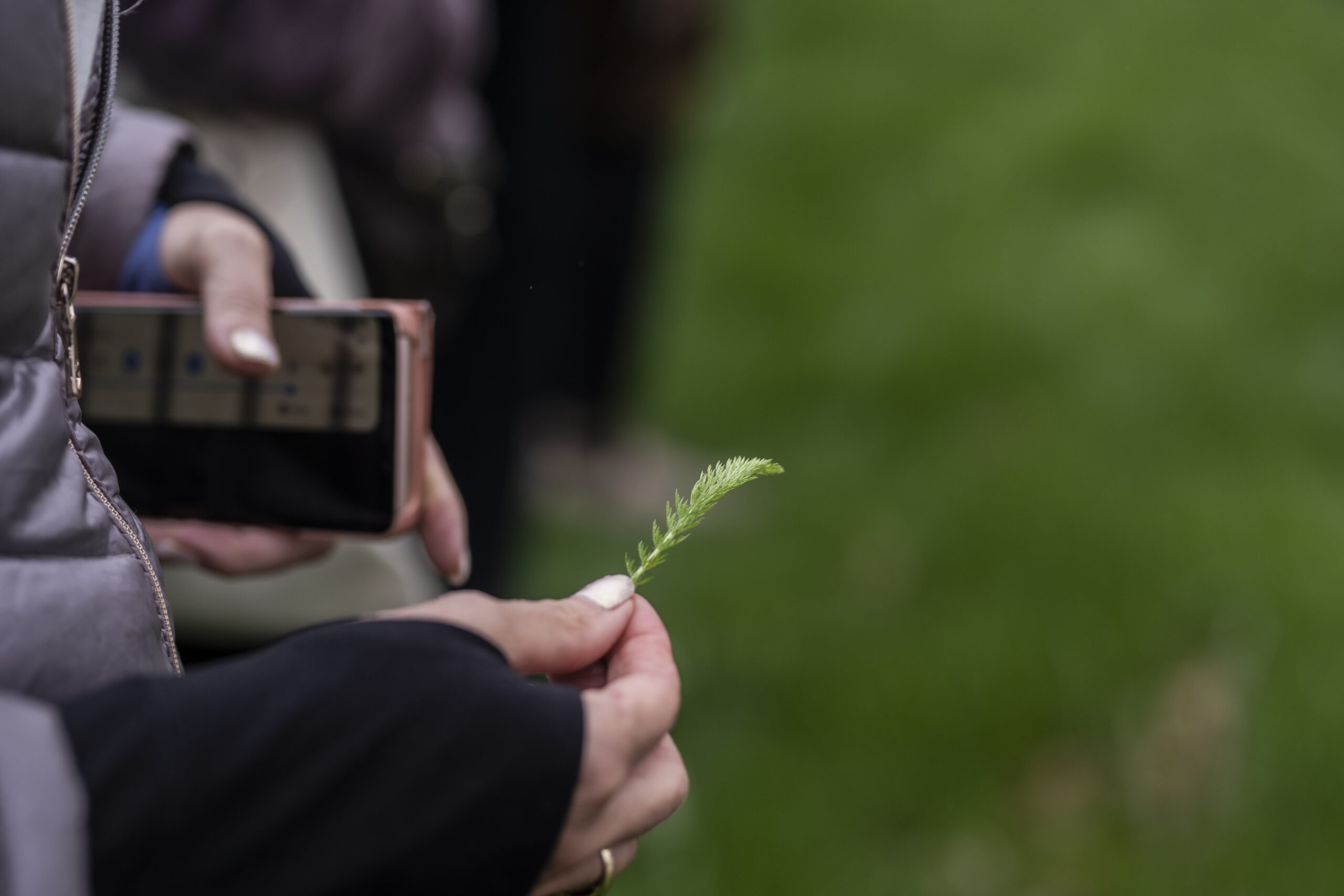Many of us can agree that we could use more time for self-care. Not the trendy brand-building “fix yourself” posts we often see on social media, but the awkward, messy, and often uncomfortable practice of learning how to take better care of ourselves. Can you imagine what it would be like if our organizational cultures supported us in creating that space?
Part of Filling the Well
Creativity can be an antidote to challenging times, but we can’t show up for our communities if we’re burnt out. This article is connected to episode 1 of Filling the Well, an Arts Midwest podcast created to nourish, provoke, and inspire artists and arts leaders. Dive into the art of taking care of you with two radical self-care strategists, Dr. Joi Lewis and Joe Davis. Then, think about how to bring this work into your organizational culture in this article from Joe Davis!

We live in a pervasive “grind culture” that has us convinced we need to be impossibly productive every second and minute of the day, but human beings are not machines and we need space for rest and play.
If we’re not proactive and intentional about taking the time for self-care, our bodies will eventually force us to make the time. We don’t need stats, graphs, and charts to tell us about the climbing rates of burnout and fatigue–we see it throughout the workplace if we haven’t already felt it in our own aching bodies.
The good news is we don’t need to wait for crisis, conflict, or chaos to respond. We can develop daily practices that shift our bodies and our culture. Here are several practices that you can integrate into your organizational culture to help you get grounded, get connected, and get creative.
Get Grounded
How much of a difference would it make if you started off meetings with a five-minute pause to breathe, ground, and get present? Although taking the time to slow down may feel counterproductive, research has shown practices of mindfulness, meditation, or intentional breathing can increase clarity and focus.
I remember how hard it was to quiet my mind when I first began meditating. I felt frustrated, impatient, and distracted–thinking about what I wanted for lunch or wondering whether or not I forgot my clothes in the dryer. But I didn’t give up. After weeks of guided YouTube videos and binaural beats, I realized that it wasn’t about “doing it right” or “doing it wrong”, but giving myself the opportunity to “just be” without the weight of inner criticism, expectation, or judgment.
I felt lighter and more energized. I experienced a deeper level of attentiveness and awareness. My interactions with others and the world around me came alive with a richer vibrancy and texture. My mind felt the difference between being like a pinball wildly ricocheting off anything it touched and being firmly rooted like a tall, strong tree dancing in the wind.
Finding just a few moments to center and ground before tackling tasks can have profound impacts on how we move throughout the rest of our day. We need breaks. Not just a lunch break with barely enough time to scarf down microwaveable leftovers, but time to check in with our hearts and minds.
Structure schedules to prioritize time set aside for the sole purpose of grounding and orienting.* You don’t need to cross your legs and chant “om” while tuning a singing bowl–unless that’s already authentic to your practice. You can simply lengthen your spine, loosen your jaw, and breathe deeply and slowly as gravity gently holds you closer than you noticed before.
Grounding in Action
A short grounding session can include soft music, humming, singing, rocking, stretching, or massaging for anywhere from five to ten minutes. Grounding is about simply allowing the room for each person to offer their body whatever it needs in the moment to be relaxed, settled, and fully present.
Even when the frustration, impatience, distractions come–and sooner or later they will inevitably come–you can always return, again and again, to an imperfect practice of finding ease and stillness within.
Can you create the needed time and space for grounding at the top of the agenda, in between Zoom meetings, or as a regular entry on your Google Calendar? We have to protect this time like it’s nonnegotiable or as important as that urgent all-staff meeting–because it is.
Our bodies will thank us for it later. Consider it a gift to your future self.
The reward is that you’ll ultimately feel healthier and more whole and–although it’s not the primary goal–it can even contribute to more productivity and may turn your workplace into a place where (gasp!) people actually enjoy being.
How can we incorporate otherwise individualistic self-care practices into the larger community culture? If we lead with humility and vulnerability then we can cultivate an environment that feels safe enough for others to bring their full, authentic selves.
Get Connected
We put so many demands on ourselves and each other, but when will we demand the centering of our collective mental health and emotional well-being? Beyond online evaluation forms and survey boxes that attempt to gauge the temperature of the workplace, we can develop more robust ways to check-in with the group that also lead to stronger relationships and a more optimal work climate.
Connecting in Action
Before beginning, it’s helpful to first clear any clutter and make sure everyone is comfortably seated in a circle or at least in a way that lets people see each other’s faces, ideally turning screens on if in an online setting.
It’s also key to be mindful of the lighting of the room and any colors or images on the walls. There’s an art and a science to designing an atmosphere conducive to community building, but it’s perhaps most important to consider what makes the group feel at home in their bodies and safe in the space—even if you need to ask them what that is. The intentionality of how you organize the physical space will shape the experience of the participants.
In order for the group to build the trust and sense of belonging necessary for these practices, they should be invited into a posture of openness and compassionate curiosity.
Compassionate curiosity is about minimizing assumed characteristics and maximizing discovered characteristics. Instead of turning to conclusions, assumptions, and snap judgments about the people around us, we lean into awe, wonder, and curiosity, expecting to be joyfully surprised by what we might discover about each other.
Once everyone is grounded and settled, you can guide the circle in a series of prompts. Feel free to revise the language of the questions, only use the prompts that are relevant to the participants, or create your own affirmations and conversation starters.
As folks respond to the prompts, they can either turn and talk to one person next to them for 3-5 minutes and then share with the group or you can go around the circle and ask them to share individually.
-
Prompts might include:
- Describe your favorite…dessert, vacation destination, tv show etc. You can fill in the blank with any topic you feel the group will connect with most meaningfully.
- Name 3 things we may not know about you just by looking at you.
- Tell the story of your name or name of someone you care about (family member, close friend, or mentor).
After the conversations, take note of how the energy in the room might’ve shifted. This circle practice is one way of acknowledging all the voices and letting each and every person know they’re seen, they’re heard, and they matter. I even like to repeat these words as a community mantra after someone shares a personal story or something particularly vulnerable about themselves: We see you. We hear you. You matter. It can be even more powerful when spoken as a collective response.
Repeating mantras or phrases like this may feel awkward the first few times, but after a while it can contribute to a culture of validation and acceptance.
As a closing ritual, go around the circle and invite each person to offer a positive affirmation to the person next to them. Try to avoid statements about physical appearances as this can often be a sensitive subject and an important boundary to honor.
For those who are introverted or simply don’t like speaking in front of groups, the prompt responses or affirmations can also be written instead of said aloud. Passing around sticky notes can be one inclusive and accessible way for folks to still engage. Perhaps some of the responses and affirmations could even be hung up next to desks or on boards–simple touches to boost morale and positivity.
Exercises like this can significantly strengthen relationships and group cohesion. Whereas questions about work usually generate surface-level answers or there may even be subtle social pressure to downplay criticism or problem-naming, these communal practices can help build a strong enough container to hold vulnerability and discomfort. When a safe enough space is established, people are inspired to open up with more honesty and authenticity. You can go deeper and more readily unearth what is essential, what matters most, and what is at the heart of the work you do together–which will subsequently make the work you do even more effective, impactful, and transformative.
Get Creative
When we truly feel grounded and connected we can access a deep well of creativity. The power of creative expression cannot be underestimated. How much more transformative could your organization be if you set aside an intentional, designated space to cultivate creativity?
Creativity in Action
Implementing blocks of time dedicated to creative sessions in your work schedule is one way to explore and experiment with new, innovative ideas. You can arrange a creative corner or assemble a box full of art supplies to employ during the sessions. I like to call this a “collaboratory,” a space intended for imagination and collaboration. People will likely want to visit the collaboratory to play with the supplies during breaks throughout the day, to release stress, or harness inspiration.
-
A collaboratory might include:
- Old magazines, newspapers, coloring books
- Crayons, markers, colored pencils
- Construction paper
- Stickers
- Scissors
- Tape
- Glue
You can come up with fun games and prizes to incentivize interaction and engagement. The collaboratory may become a centralized spot for the community to find recharge and rejuvenation. This would be the perfect place for what I call the Jar of Joy, where people can gather and share jokes, inspiring quotes, and positive affirmations inside a jar. They can only take one out if they put one in.
You can even transfer the idea of the collaboratory into a shared digital space via social media like Facebook, apps like Pinterest, or a folder on Google Drive, where the group collects videos, gifs, and memes that bring them joy.
Carving out the time for practices of care can be simple yet profound. There is no shortage of care. We only need to make the space for it.
It’s up to us. No one else can tend to our own well-being as intentionally as we can. We must learn to take better care of ourselves not only for the sake of healthier organizational culture but if we want to survive as a species.
